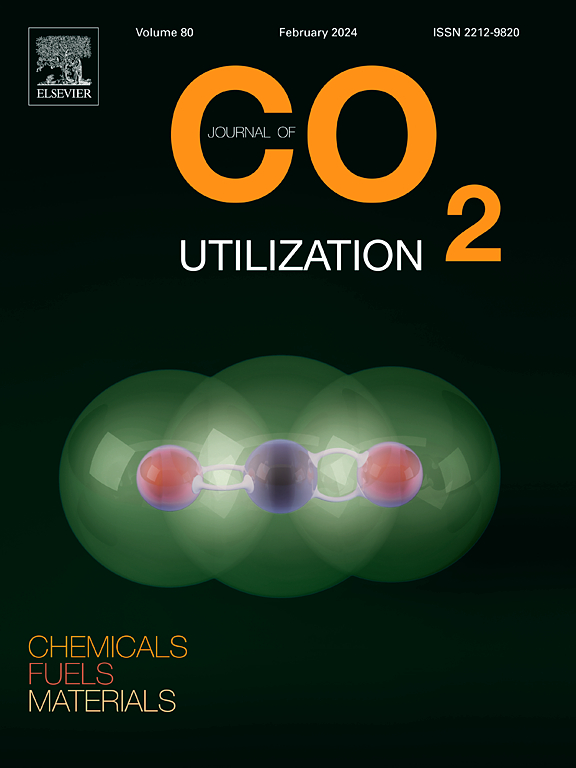Mid-temperature CO2 deoxygenation to CO over Fe-CeO2
IF 7.2
2区 工程技术
Q1 CHEMISTRY, MULTIDISCIPLINARY
引用次数: 0
Abstract
CO2 capture and utilization is a must for easing the global warming caused by the uses of fossil fuels. We examine M-CeO2 (M = Cu, Co, and Fe @M/Ce = 2/8) prepared by coprecipitation and hard template synthesis. Fe-CeO2 is the only one showing thermal CO2 deoxygenation to CO at below 700 °C after reduction. XRD analyses of as prepared Fe-CeO2 demonstrate the presence of segregated Fe2O3 and CeO2 phases with partial mixing. Both Fe2O3 phase and CeO2 phase show redox during sequential TPR (temperature-programmed reduction)-CO2-TPRx (temperature-programmed reaction) up to 700 °C. The evolved Fe0 after TPR appears to be the main active phase for CO2 deoxygenation which becomes oxidized back to Fe2O3 after CO2-TPRx. The results indicate that the interface (interphase) between Fe-domain and CeO2-domain is involved leading to the observed deoxygenation reactivity. That the stripped oxygen from CO2 over Fe-domain can spillover to CeO2 domain is considered as a possible explanation. We perform isothermal CO2 deoxygenation test at 600 °C over TPR-treated Fe-CeO2 using oxygen-conducting membrane reactor, and the CO2 deoxygenation capacity is found significantly higher than that observed when in the absence of oxygen conducting membrane. This demonstrates not only the possible oxygen spillover but also the possibility of achieving a sustainable CO2 deoxygenation process.
中温二氧化碳在 Fe-CeO2 上脱氧生成 CO
二氧化碳的捕获和利用是缓解化石燃料使用造成的全球变暖的必要条件。研究了用共沉淀法和硬模板法合成的M- ceo2 (M = Cu, Co, Fe @M/Ce = 2/8)。Fe-CeO2是唯一一种还原后温度低于700 ℃时CO2热脱氧为CO的产物。对制备的Fe-CeO2的XRD分析表明,在部分混合的情况下,存在分离的Fe2O3和CeO2相。在高达700 °C的顺序TPR(程序升温还原)- co2 -程序升温反应中,Fe2O3相和CeO2相均表现出氧化还原。TPR后析出的Fe0是CO2脱氧的主要活性相,在CO2- tprx后又被氧化回Fe2O3。结果表明,fe畴与ceo2畴之间的界面(界面相)参与了所观察到的脱氧反应。从CO2中剥离出的氧在fe域上可以溢出到CeO2域被认为是一个可能的解释。我们使用导氧膜反应器对tpr处理过的Fe-CeO2在600 °C下进行等温CO2脱氧实验,发现其CO2脱氧能力明显高于无导氧膜时的脱氧能力。这不仅证明了可能的氧气溢出,而且证明了实现可持续的二氧化碳脱氧过程的可能性。
本文章由计算机程序翻译,如有差异,请以英文原文为准。
求助全文
约1分钟内获得全文
求助全文
来源期刊

Journal of CO2 Utilization
CHEMISTRY, MULTIDISCIPLINARY-ENGINEERING, CHEMICAL
CiteScore
13.90
自引率
10.40%
发文量
406
审稿时长
2.8 months
期刊介绍:
The Journal of CO2 Utilization offers a single, multi-disciplinary, scholarly platform for the exchange of novel research in the field of CO2 re-use for scientists and engineers in chemicals, fuels and materials.
The emphasis is on the dissemination of leading-edge research from basic science to the development of new processes, technologies and applications.
The Journal of CO2 Utilization publishes original peer-reviewed research papers, reviews, and short communications, including experimental and theoretical work, and analytical models and simulations.
 求助内容:
求助内容: 应助结果提醒方式:
应助结果提醒方式:


